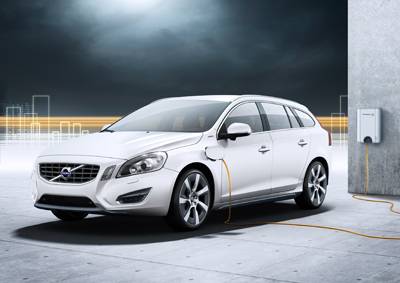The Volvo V60 Plug-in Hybrid

The Volvo V60 Plug-in Hybrid
Volvo Cars' V60 Plug-in Hybrid made its southern hemisphere debut at the Australian International Motor Show in Melbourne on 1st July. Giving car enthusiasts the opportunity to go green without compromising on luxury, style, safety and power, the V60 Plug-in Hybrid integrates the very best properties from three different car types into one.
In 2012, the V60 Plug-in Hybrid will be the first car in the market with this new breed of hybrid, which is the result of close work by Volvo Cars with Swedish energy supplier Vattenfall. The iconic sports wagon enables drivers the choice of three cars in one and allows them to simply press a button to choose which car / mode they want to drive:
Pure: An electric car with a range of up to 50 kilometres and pumping out zero exhaust emissions.
Hybrid: A combination of the diesel engine and electric motor to save fuel by using only 1.9 litre per 100kms and emitting under 50 grams carbon dioxide per kilometre
Power: Focusing on performance, enabling the V60 to go from 0-100km/h in just 6.9 seconds despite the extra weight from the batteries and electrics.
The V60 Plug-in Hybrid is part of Volvo Car's "DRIVe Towards Zero" vision for developing cars with zero emissions. Since the car was first unveiled in Geneva this year, it has been getting rave reviews for its styling, fuel efficiency and environmental efficiencies.
Some of the V60 Plug-in Hybrid's key features tailored to consumer lifestyles that set it distinctly apart and ahead in its class are:
Cheaper fuel costs: The cost of the battery pack means the V60 Plug-in Hybrid will be more expensive than a Volvo V60 with a conventional combustion engine. However, with fuel consumption of just 1.9 liter per 100 kms (using regular diesel), ongoing fuel costs will be one-third compared with a conventional combustion engine. To put this in perspective, a 1,000 kms drive (average distance from Sydney to Melbourne) would cost the driver under $30 per current average fuel prices in Australia.
Convenient battery recharging at home: The plug-in hybrid can be charged via a regular household electricity socket at home or when parked somewhere else. Charging time is about five hours if the car is recharged at home.
Elimination of range-anxiety: Easy conversion to long distance drives in hybrid mode (from electric after 50 kms) whilst still maintaining low carbon emissions and not having to worry about recharging battery en-route.
Electric power offering a range of benefits: Electrification of the transport sector is an important step in the fight against climate change. Electricity is an excellent source of energy. It does not risk running out, and it can be produced virtually without any CO2 emissions.
CO2-lean exterior features: Lightweight wheels with exceptionally low air drag and Pirelli tyres designed for low rolling resistance emphasise its CO2-lean profile.
Mobile applications and communication: Owners will be able to communicate with the car via a mobile application. This gives them access to a number of smart features, such as a reminder to plug in the charging cable if this hasn't been done at a certain, pre-set time.
World-first and uncompromised safety: In addition to all safety systems available in the V60, such as the world-first Pedestrian Detection with full auto brake, Volvo's safety experts have meticulously analysed different accident scenarios related to battery powered and electric cars.
"The V60 Plug-in Hybrid has all the traditional properties of a genuine sports wagon. What we've done is to spice it up with spearhead technology that allows the driver to choose: zero emissions, high-efficiency hybrid or full-on performance. Just select the mode that suits you best," says Stefan Jacoby, President and CEO of Volvo Cars.
MORE





